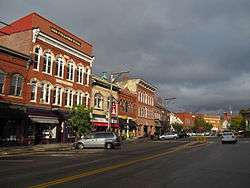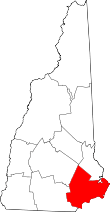Exeter, New Hampshire
| Exeter, New Hampshire | ||
|---|---|---|
|
Water Street in downtown Exeter | ||
| ||
 Location in Rockingham County and the state of New Hampshire. | ||
| Coordinates: 42°58′53″N 70°56′52″W / 42.98139°N 70.94778°WCoordinates: 42°58′53″N 70°56′52″W / 42.98139°N 70.94778°W | ||
| Country | United States | |
| State | New Hampshire | |
| County | Rockingham | |
| Incorporated | 1638 | |
| Government | ||
| • Board of Selectmen |
Julie Gilman, Chair Dan Chartrand Donald Clement Nancy Belanger Anne Surman | |
| • Town Manager | Russell Dean | |
| Area | ||
| • Total | 20.0 sq mi (51.8 km2) | |
| • Land | 19.6 sq mi (50.9 km2) | |
| • Water | 0.4 sq mi (1.0 km2) 1.85% | |
| Elevation | 33 ft (10 m) | |
| Population (2010) | ||
| • Total | 14,306 | |
| • Density | 729.9/sq mi (281.8/km2) | |
| Time zone | Eastern (UTC-5) | |
| • Summer (DST) | Eastern (UTC-4) | |
| ZIP code | 03833 | |
| Area code(s) | 603 | |
| FIPS code | 33-25380 | |
| GNIS feature ID | 0873595 | |
| Website |
www | |
Exeter is a town in Rockingham County, New Hampshire, United States. The town's population was 14,306 at the 2010 census.[1] Exeter was the county seat until 1997, when county offices were moved to neighboring Brentwood. Home to the Phillips Exeter Academy, a private university-preparatory school, Exeter is situated where the Exeter River feeds the tidal Squamscott River.
The urban portion of the town, where 9,242 people resided at the 2010 census,[1] is defined by the U. S. Census Bureau as the Exeter census-designated place.
Exeter is named after the historic city in Devon, England.
History
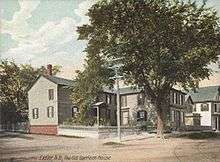
The area was once the domain of the Squamscott Native Americans, a sub-tribe of the Pennacook nation, which fished at the falls where the Exeter River becomes the tidal Squamscott, the site around which the future town of Exeter would grow. On April 3, 1638, the Reverend John Wheelwright and others purchased the land from Wehanownowit, the sagamore. Wheelwright had been exiled by the Massachusetts Bay Colony, a puritan theocracy, for sharing the dissident religious views of his sister-in-law, Anne Hutchinson. The minister took with him about 175 individuals to found the town he named after Exeter[2] in Devon, England. Local government was linked with Massachusetts until New Hampshire became a separate colony in 1679, but counties weren't introduced until 1769.
One of the four original townships in the province, Exeter originally included Newmarket, Newfields, Brentwood, Epping and Fremont. On July 4, 1639, 35 freemen of Exeter signed the Exeter Combination, a document written by Reverend Wheelwright to establish their own government.[3] The settlers hunted, planted and fished. Others tended cattle and swine, or made shakes and barrel staves.
Thomas Wilson established the first grist mill on the eastern side of the island in the lower falls. This mill was established within the first season of settling in Exeter, and his son Humphrey assumed control of the mill in 1643, when Thomas died.[4]
Some early Exeter settlers came from Hingham, Massachusetts, including the Gilman, Folsom and Leavitt families.[5][6] In 1647, Edward Gilman, Jr. established the first sawmill, and by 1651 Gilman had his own 50-ton sloop with which to conduct his burgeoning business in lumber, staves and masts. Although he was lost at sea in 1653 while traveling to England to purchase equipment for his mills,[7] his family later became prominent as lumbermen, shipbuilders, merchants and statesmen.[8][9]
The Gilman Garrison House, a National Historic Landmark, and the American Independence Museum were both former homes of the Gilman family.[10][11] The Gilman family also donated the land on which Phillips Exeter Academy stands, including the Academy's original Yard, the oldest part of campus.[12] The Gilmans of Exeter also furnished America with one of its founding fathers, Nicholas Gilman, and the state of New Hampshire with treasurers, a governor, representatives to the General Assembly and judges to the General Court.[13][14]
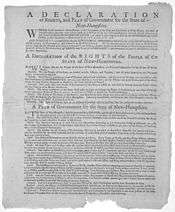
The Gilman family began trading as far as the West Indies with ships they owned out of Portsmouth. It was a high-stakes business. In an 1803 voyage, for instance, the 180-ton clipper 'Oliver Peabody,' owned by Gov. John Taylor Gilman, Oliver Peabody, Col. Gilman Leavitt and others, was boarded by brigs belonging to the Royal Navy under command of Admiral Horatio Nelson. Enforcing a blockade against the French, Nelson offered ship Captain Stephen Gilman of Exeter a glass of wine and paid him for his cargo in Spanish dollars.[15] The trip demonstrates how far afield the ambitious merchants of Exeter reached in their trading forays.
Exeter suffered its last Indian raid in August 1723 and by 1725 the tribes had left the area. In 1774 the rebellious Provincial Congress began to meet in the Exeter Town House after Colonial Governor John Wentworth banned it from the colonial capitol at Portsmouth. In July 1775, the Provincial Congress had the provincial records seized from royal officials in Portsmouth and brought to Exeter as well. And so Exeter became New Hampshire's capital, an honor it held for 14 years.[16]
In 1827, the Exeter Manufacturing Company was established beside the river, using water power to produce cotton textiles. Other businesses would manufacture shoes, saddles, harnesses, lumber, boxes, bricks, carriages and bicycles. In 1836, the last schooner was launched at Exeter. In 1840, the Boston & Maine Railroad entered the town.
According to former governor Hugh Gregg, the United States Republican Party was born in Exeter on October 12, 1853, at the Squamscott Hotel at a secret meeting of Amos Tuck with other abolitionists. At this meeting, Tuck proposed forming a new political party to be called Republican. Upon learning of Tuck's meeting, in December 1853, Horace Greeley said "I think 'Republican' would be the best name, it will sound both Jeffersonian and Madisonian, and for that reason will take well." [17] Abraham Lincoln, the first Republican president, visited Exeter in 1860. His son, Robert Todd Lincoln, was attending Phillips Exeter Academy, the college preparatory school founded in 1781 by Dr. John Phillips. The town was also once home to the Robinson Female Seminary, established in 1867 and previously known as the Exeter Female Academy (established in 1826). Its landmark Second Empire schoolhouse, completed in 1869, burned in 1961.
In September 1965 Exeter earned a place in UFO history when two Exeter police officers, Eugene Bertrand and David Hunt, witnessed a bright red UFO at close range with a local teenager, Norman Muscarello. Their sighting attracted national publicity and became the focus of a bestselling book, Incident at Exeter, by journalist John G. Fuller. The Air Force eventually admitted to the three men that it had been unable to identify the strange object they had observed, and it is still considered by many UFO buffs to be one of the most impressive UFO sightings on record.
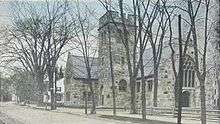
Exeter has a considerable inventory of structures by prominent architects. Arthur Gilman, descendant of one of Exeter's founding families, designed the Old Town Hall of 1855. The Old Public Library of 1894, which now is home to the Exeter Historical Society, was designed by the Boston firm of Rotch & Tilden. Ralph Adams Cram, who trained with Rotch & Tilden, designed both Phillips Church, built in 1897, and Tuck High School, built in 1911. His firm of Cram & Ferguson designed the entire Phillips Exeter Academy campus between 1908 and 1950. More recent is the noted Academy Library, built in 1971 to the design of Louis I. Kahn. Daniel Chester French, sculptor and Exeter native, created the town's war memorial in 1922. He is best known for his statue of Abraham Lincoln in Washington, D.C.at the Lincoln Memorial, which was designed by Henry Bacon, who also designed in 1916 the Swasey Pavilion at Exeter's town square.
Other features of the town include the Swasey Parkway, which replaced wharves and warehouses along the Squamscott River, and the Ioka Theatre of 1915 on Water Street. The latter was built by Edward Mayer, an Exeter judge and resident. Mayer's opening feature was The Birth of a Nation, by D. W. Griffith. The theatre's curious name was proposed in a contest by a young woman with an enthusiasm for Scouting. Ioka was a Native American word meaning playground.
 Town Offices c. 1912
Town Offices c. 1912 Squamscott Falls in 1907
Squamscott Falls in 1907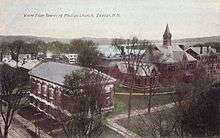 Phillips Exeter in 1910
Phillips Exeter in 1910 Linden Street c. 1909
Linden Street c. 1909 Current photograph of Exeter Town Hall - Sept 2008
Current photograph of Exeter Town Hall - Sept 2008 Powder House, 1936
Powder House, 1936 Giddings Tavern, 1935
Giddings Tavern, 1935 Liberty Emery House, 1935
Liberty Emery House, 1935 Simeon Folsom House, 1935
Simeon Folsom House, 1935 First Congregational Church, c. 1870
First Congregational Church, c. 1870 Lower falls in winter, c. 1870
Lower falls in winter, c. 1870 Town Hall, c. 1870
Town Hall, c. 1870 Bellows House, Front Street, c. 1870
Bellows House, Front Street, c. 1870 Robinson Female Seminary, now defunct, c. 1870
Robinson Female Seminary, now defunct, c. 1870 Front Street, c. 1870
Front Street, c. 1870 Phillips Exeter Academy, c. 1870
Phillips Exeter Academy, c. 1870
Geography
According to the United States Census Bureau, the town has a total area of 20.0 square miles (52 km2), of which 19.6 sq mi (51 km2) is land and 0.4 sq mi (1.0 km2) is water, comprising 1.85% of the town. Exeter is drained by the Exeter River, which feeds the Squamscott River. The highest point in Exeter is 250 feet (76 m) above sea level on Great Hill at the town's southwest corner. Exeter lies fully within the Piscataqua River (Coastal) watershed.[18]
The town's center, defined as a census-designated place (CDP), has a total area of 4.5 square miles (12 km2), of which 4.4 sq mi (11 km2) is land and 0.2 sq mi (0.52 km2) (3.74%) is water.
Demographics
| Historical population | |||
|---|---|---|---|
| Census | Pop. | %± | |
| 1790 | 1,722 | — | |
| 1800 | 1,727 | 0.3% | |
| 1810 | 1,759 | 1.9% | |
| 1820 | 2,114 | 20.2% | |
| 1830 | 2,759 | 30.5% | |
| 1840 | 2,925 | 6.0% | |
| 1850 | 3,329 | 13.8% | |
| 1860 | 3,309 | −0.6% | |
| 1870 | 3,347 | 1.1% | |
| 1880 | 3,569 | 6.6% | |
| 1890 | 4,284 | 20.0% | |
| 1900 | 4,922 | 14.9% | |
| 1910 | 4,897 | −0.5% | |
| 1920 | 4,604 | −6.0% | |
| 1930 | 4,872 | 5.8% | |
| 1940 | 5,398 | 10.8% | |
| 1950 | 5,664 | 4.9% | |
| 1960 | 7,243 | 27.9% | |
| 1970 | 8,892 | 22.8% | |
| 1980 | 11,024 | 24.0% | |
| 1990 | 12,481 | 13.2% | |
| 2000 | 14,058 | 12.6% | |
| 2010 | 14,306 | 1.8% | |
| Est. 2015 | 14,567 | [19] | 1.8% |
.jpg)
As of the census of 2010, there were 14,306 people, 6,114 households, and 3,729 families residing in the town. The population density was 729.9 people per square mile (281.1/km²). There were 6,496 housing units at an average density of 331.4 per square mile (127.6/km²). The racial makeup of the town was 95.5% White, 0.6% African American, 0.1% Native American, 2.0% Asian, 0.2% some other race, and 1.6% from two or more races. Hispanic or Latino of any race were 1.77% of the population.[21]
There were 6,114 households, out of which 29.1% had children under the age of 18 living with them, 47.5% were headed by married couples living together, 9.8% had a female householder with no husband present, and 39.0% were non-families. 32.5% of all households were made up of individuals, and 15.2% were someone living alone who was 65 years of age or older. The average household size was 2.28, and the average family size was 2.92.[21]
In the town the age distribution of the population was 22.6% under the age of 18, 6.0% from 18 to 24, 22.5% from 25 to 44, 30.8% from 45 to 64, and 18.2% who were 65 years of age or older. The median age was 44.3 years. For every 100 females there were 88.6 males. For every 100 females age 18 and over, there were 84.9 males.[21]
For the period 2007-11, the estimated median annual income for a household in the town was $68,777, and the median income for a family was $95,435. Male full-time workers had a median income of $64,632 versus $41,088 for females. The per capita income for the town was $38,018. About 2.5% of families and 5.7% of the population were below the poverty line, including 7.2% of those under age 18 and 4.1% of those age 65 or over.[22]
Town center
As of the census of 2010, there were 9,242 people, 4,077 households, and 2,368 families residing in the central urban settlement. The population density was 2,100.5 people per square mile (810.7/km²). There were 4,342 housing units at an average density of 986.8 per square mile (380.9/km²). The racial makeup of the CDP was 95.3% White, 0.6% Black or African American, 0.1% Native American, 2.0% Asian, 0.2% some other race, and 1.8% from two or more races. Hispanic or Latino of any race were 1.6% of the population.[23]
There were 4,077 households, out of which 28.3% had children under the age of 18 living with them, 42.4% were headed by married couples living together, 11.6% had a female householder with no husband present, and 41.9% were non-families. 34.5% of all households were made up of individuals, and 13.5% were someone living alone who was 65 years of age or older. The average household size was 2.23, and the average family size was 2.88.[23]
In the CDP the age distribution of the population was 22.1% under the age of 18, 6.7% from 18 to 24, 24.2% from 25 to 44, 31.8% from 45 to 64, and 15.4% who were 65 years of age or older. The median age was 43.2 years. For every 100 females there were 90.2 males. For every 100 females age 18 and over, there were 86.7 males.[23]
For the period 2007-11, the estimated median annual income for a household in the CDP was $61,367, and the median income for a family was $86,852. Male full-time workers had a median income of $59,196 versus $39,583 for females. The per capita income for the CDP was $34,685. About 3.3% of families and 7.2% of the population were below the poverty line, including 11.1% of those under age 18 and 4.9% of those age 65 or over.[24]
Transportation
The Amtrak Downeaster stops at Exeter, providing passenger rail service to Portland and Boston.
Exeter is served by four exits (9–12) from Route 101, and Interstate 95 is about 5 miles (8 km) to the east. Routes 27, 85, 108, 111, and 111A meet at the town's center, and Route 88 is on the east side of the town.
Economy
In 1990 the SIGARMS, Inc. company moved to Exeter. When it was bought by Michael Lüke and Thomas Ortmeier in October 2000, the name was changed to SIG Sauer Inc. Today, SIG Sauer is the largest of the five companies and one of the largest firearms manufacturing entities in the world.[25] It is also the fastest growing firearms maker in the United States, expanding its operations and increasing sales nearly 50% since 2005. SIG Sauer has recently tripled its work force and invested eighteen million dollars into state-of-the-art manufacturing facilities and equipment.[25]
According to SIG Sauer, one-third of US police use SIG firearms.[26]
Notable people
See also
Sites of interest
- American Independence Museum
- Exeter Congregational Church, founded 1638
- Christ Episcopal Church, founded 1865
- The Exeter Historical Society & Museum
- Gilman Garrison House (1709)
- Phillips Exeter Academy
- Exeter High School
References
- 1 2 United States Census Bureau, American FactFinder, 2010 Census figures. Retrieved March 23, 2011.
- ↑ Gannett, Henry (1905). The Origin of Certain Place Names in the United States. Govt. Print. Off. p. 122.
- ↑ Fitts, James Hill (1912). History of Newfields, New Hampshire, 1638-1911. Concord, NH: The Rumford Press. p. 22. Retrieved 22 October 2010.
- ↑ Bell, Charles H. (1888). History of the Town of Exeter, New Hampshire. Boston, MA: J. E. Farwell. pp. 317–318. Retrieved 22 October 2010.
- ↑ Lincoln, Solomon (1827). History of the Town of Hingham, Plymouth County, Massachusetts. Hingham, MA: Farmer and Brown. pp. 174–175.
- ↑ John Leavitt, founding deacon of Old Ship Church in Hingham, was granted land in Exeter in 1652, but there is no sign that he took up residence. But his sons Moses and Samuel Leavitt moved to Exeter, presumably to be closer to their maternal grandfather, Edward Gilman Sr."WALF Memoriam to the Children of John Leavitt and Sarah Gilman, Hingham Cemetery, Hingham, Massachusetts". Flickr. Retrieved 22 October 2010.
- ↑ Savage, James; John Farmer; Orrando Perry Dexter (1860). A Genealogical Dictionary of the First Settlers of New England, Vol. II. Boston, MA: Little, Brown and Company.
- ↑ Perley, Sidney (July 1905). "Suffolk County Deeds, Vol. 1". The Essex Antiquarian. Salem, MA. IX (3): 103. Retrieved 22 October 2010.
- ↑ Perley, Sidney (July 1897). "Old Norfolk County Records". The Essex Antiquarian. Salem, MA. I (7): 115. Retrieved 22 October 2010.
- ↑ "Gilman Garrison House". Historic New England. Historic New England. Retrieved 2010-10-22.
- ↑ "The Ladd-Gilman House". The American Independence Museum. Retrieved 2010-10-22.
- ↑ Gilman, Alexander (1895). Searches Into the History of the Gillman or Gilman family. London: E. Stock. p. 214. Retrieved 22 October 2010.
- ↑ Merrill, Nancy. "The Gilmans of Exeter". SeacoastNH.com. Retrieved 2010-10-22.
- ↑ Bell, Charles Henry. John Taylor Gilman, M. D., Portland Maine: A memorial for the family.
- ↑ Brewster, Charles Warren (1869). Rambles About Portsmouth. Portsmouth, NH: Lewis W. Brewster. p. 291. Retrieved 22 October 2010.
- ↑ "Exeter - Its History". American Independence Museum. Retrieved March 23, 2015.
- ↑ "Birth of the Republican Party", H. Gregg
- ↑ Foster, Debra H.; Batorfalvy, Tatianna N.; Medalie, Laura (1995). Water Use in New Hampshire: An Activities Guide for Teachers. U.S. Department of the Interior and U.S. Geological Survey.
- ↑ "Annual Estimates of the Resident Population for Incorporated Places: April 1, 2010 to July 1, 2015". Retrieved July 2, 2016.
- ↑ "Census of Population and Housing". Census.gov. Retrieved June 4, 2016.
- 1 2 3 "Profile of General Population and Housing Characteristics: 2010 Demographic Profile Data (DP-1): Exeter town, Rockingham County, New Hampshire". U.S. Census Bureau, American Factfinder. Retrieved March 4, 2013.
- ↑ "Selected Economic Characteristics: 2007-2011 American Community Survey 5-Year Estimates (DP03): Exeter town, Rockingham County, New Hampshire". U.S. Census Bureau, American Factfinder. Retrieved March 4, 2013.
- 1 2 3 "Profile of General Population and Housing Characteristics: 2010 Demographic Profile Data (DP-1): Exeter CDP, New Hampshire". U.S. Census Bureau, American Factfinder. Retrieved March 4, 2013.
- ↑ "Selected Economic Characteristics: 2007-2011 American Community Survey 5-Year Estimates (DP03): Exeter CDP, New Hampshire". U.S. Census Bureau, American Factfinder. Retrieved March 4, 2013.
- 1 2 About Us
- ↑ SIG Sauer Military/LE customers
External links
| Wikimedia Commons has media related to Exeter, New Hampshire. |
| Wikivoyage has a travel guide for Exeter, New Hampshire. |
| Wikisource has the text of an 1879 American Cyclopædia article about Exeter, New Hampshire. |
- Town of Exeter official website
- Exeter Historical Society
- SAU 16, Exeter Area School District
- Exeter Public Library
- New Hampshire Economic and Labor Market Information Bureau Profile
- Squamscott Community Commons, community center in progress
Further reading
- Cross-Grained & Wiley Waters: A Guide to the Piscataqua Maritime Region, Jeffrey W. Bolster, Editor; Peter Randall Publisher, Portsmouth, 2001
- Exeter New Hampshire 1888-1988, Nancy C. Merrill; Peter E. Randall, Publisher, Exeter, NH 1988
- History of Exeter, New Hampshire, Charles H. Bell, Exeter, NH 1888; Reprinted by Heritage Books, 1990
- Images of America: Exeter, Carol Walker Aten; Arcadia Publishers, Dover, NH, 1996, reprint 1998
- Ports of Piscataqua: Soundings in the Maritime History of the Portsmouth, N.H., Customs District from the Days of Queen Elizabeth and the Planting of Strawberry Banke to the Times of Abraham Lincoln and the Waning of the American Clipper, William Gurdon Saltonstall, Harvard University Press, Cambridge, 1941
- Postcards from Exeter, Carol Walker Aten; Arcadia Publishers, Dover, NH, 2003
- The Exeter-Squamscott: River of Many Uses, Olive Tardiff; Peter E. Randall, Publisher, Exeter, NH 1986, 2004
